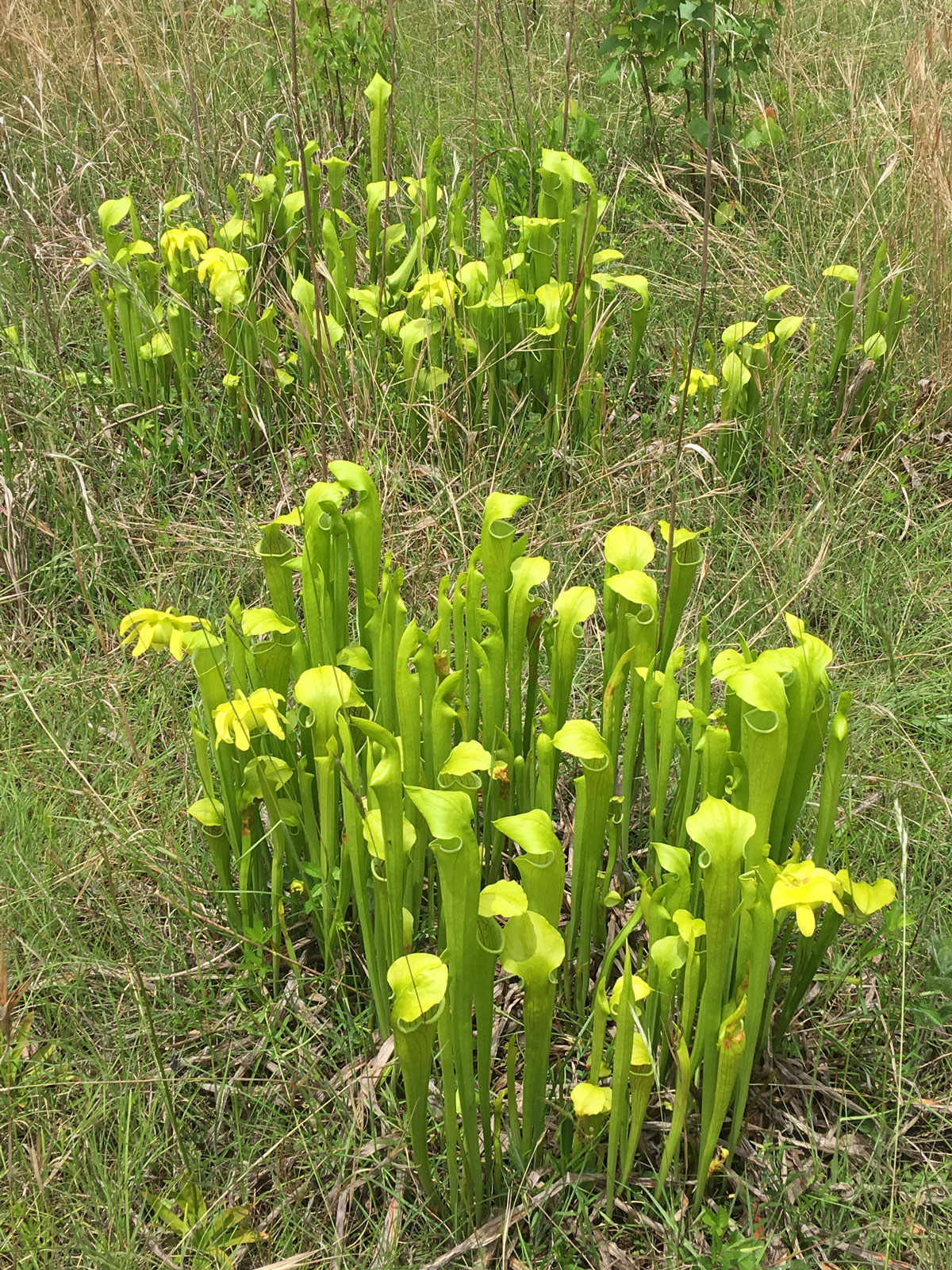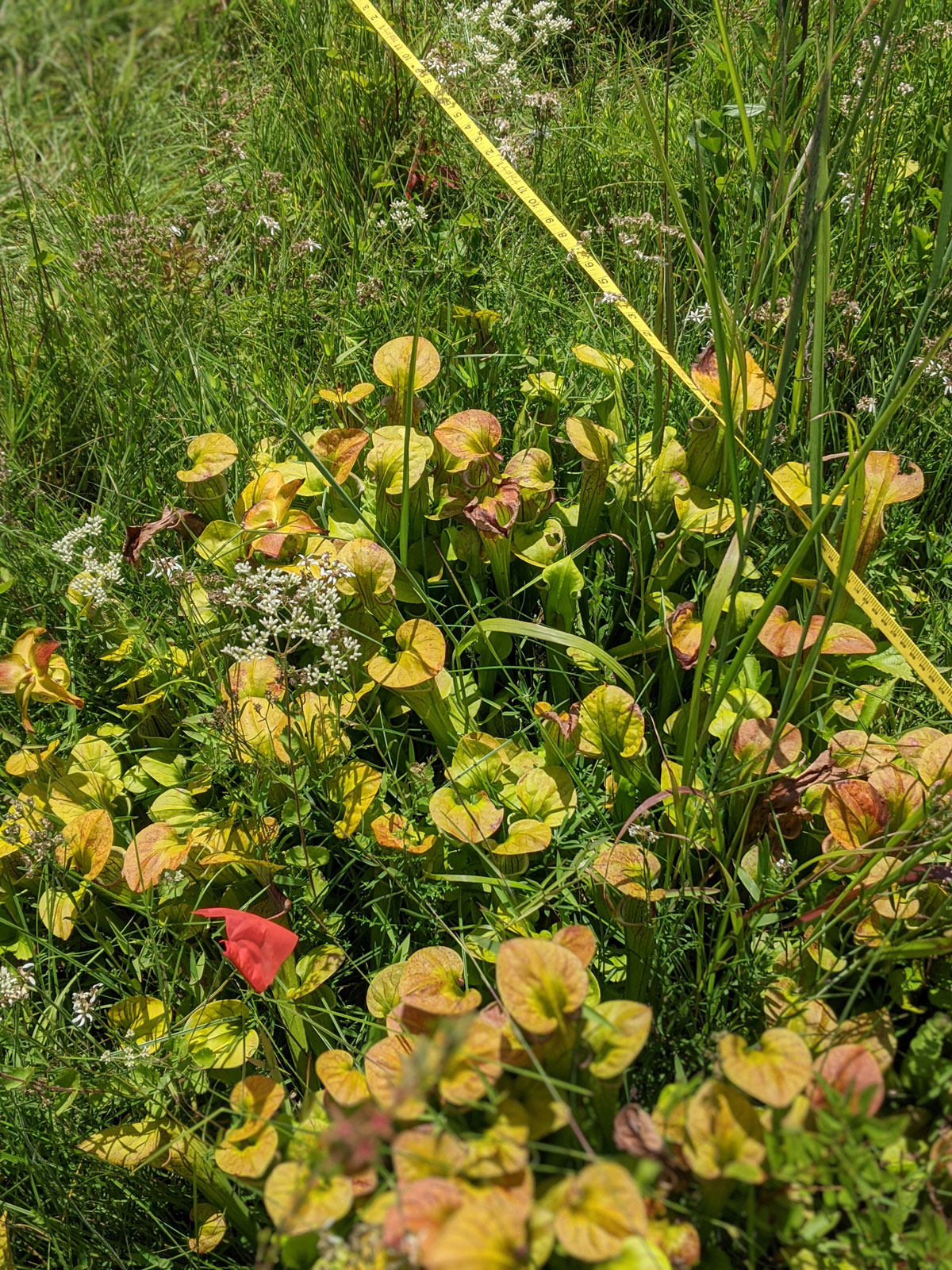A Carnivorous Ambassador
A rare treat greets scout troops guided by Carrie Radcliffe on lands managed by the Nature Conservancy (TNC) in Georgia: endangered green pitcher plants (Sarracenia oreophila) in their natural, boggy habitats. Faces of scouts and adults light up as they experience the reality of carnivorous plants and the special places in which they live. Although the species’ range stretches over several states, such encounters are rare. Green pitcher plants reside in isolated and scattered see page bog habitats. These bogs, already few in number, are declining further in the face of agricultural development, changes in disturbance regimes (such as fire), changes in hydrology, and other threats. Fortunately, Atlanta Botanical Garden (the Garden), where Carrie works, has a bog display in its Conservation Garden where visitors can experience the wonder of these carnivorous plants.
The green pitcher plant is a charismatic ambassador for the plight of endangered plants. Pitcher plants have a unique shape that begs a closer look, rewarding admirers with insight into how these botanic predators trap insects for nutrients. At the Garden, the education department collects pitcher plant material for children to explore in classes, and the plants are often on display at a fundraising events. Carrie describes the reactions of children and adults as a “spark of wonder as these plants’ mysteries unravel before their eyes.” The staff use the charisma of pitcher plants to promote both an appreciation for plants and an awareness of their needs. The green pitcher plant provides a superb example of a conservation success, showing how imperiled plants can be helped when their needs are addressed. Carrie’s hope is that this story will continue to inspire the public, especially future conservation biologists and stewards of nature.
-

Green pitcher plant. Photo by: Carrie Radcliffe -

Green pitcher plant (Sarracenia oreophila) in its bog habitat during recovery plan monitoring with the Bog Learning Network in Georgia in the spring of 2018. Photo by: Carrie Radcliffe -

The green pitcher plant gains new colors as the year progresses, here sporting orange and yellow during floral monitoring for maternal line seed collections. Photo by: Emily Coffey
The green pitcher plant has drawn many to its cause. Population sites in Georgia and North Carolina are conserved by TNC and have been actively managed for a long time. Management efforts continue to improve as researchers working with conservationists in the Southern Appalachia Bog Learning Network (BLN) increase the understanding of the bog hydrology and plant needs. The Georgia Plant Conservation Alliance (GPCA) has helped lead monitoring, management, and plant enhancements for green pitcher plants in Georgia. They have also served as a mentor for the Alabama PCA as it began to reverse the decline of the their Populations where we have supplied plants and helped with work days included public and private lands. The work of these collaborative groups benefits multiple pitcher plant species (Sarracenia oreophila, S. jonesii, and S. purpureavar. montana), as well as many other plant and animal species endemic to boggy habitats in the mountains, such as swamp pink and bog turtle.
Within this web of conservationists, the Garden plays a few key roles, both leading and supporting. Their primary work continues to be conservation horticulture and seed banking. When called upon, the team will also hop over to Alabama to help with a work event and monitor populations. They maintain indexed conservation collections –living plants with origin and parentage tracked. In 2006, a population augmentation using living collections was conducted at a microsite adjacent to the main Georgia population. Seed collections are being made to include the species in CPC’s upcoming IMLS longevity study and to maintain collection diversity by maternal lines. The Garden’s efforts to capture the diversity of the North Carolina and Georgia populations through seed banking will soon extend to Alabama. And use of material supplied by the Garden for reintroductions at new sites within the natural range of the species remains a hopeful possibility.
In the meantime, the Garden continues to monitor the 2006 augmentation and promote the plight and progress of green pitcher plant to the public. According to Carrie, the species may never reach the goal of having 18 stable populations on protected lands, as is currently required for delisting. Yet great advances have already been made through the work of the Garden, The Nature Conservancy, the PCAs, the BLN, U.S. Fish and Wildlife Service, and future benefits for this species will grow out of further collaboration across its range. Conservationists working with green pitcher plant have great hopes that it will continue to be a model for success and an ambassador for developing partnerships, including the Southeastern Plant Conservation Alliance, as well as other plants in need of collaborative efforts.